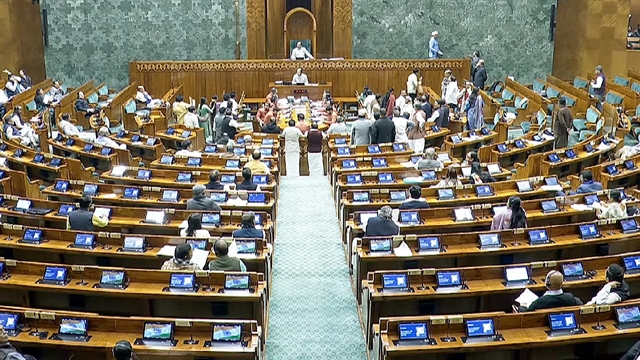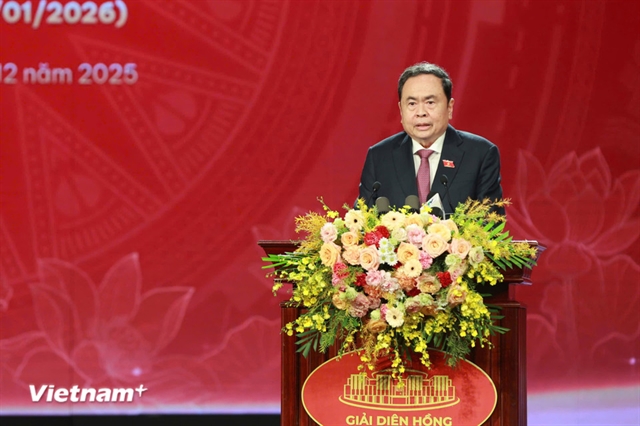.jpg) Society
Society

 |
| Local residents receive preferential loans for economic development at a transaction point in Mai Châu District in the northern province of Hòa Bình. VNA/VNS Photo Trần Việt |
HÀ NỘI — Việt Nam has achieved a significant milestone by reducing the poverty rate among ethnic communities to nearly four per cent, an accomplishment largely attributed to the National Target Programme for Socio-Economic Development in Ethnic Minority and Mountainous Areas.
Minister of Ethnic and Religious Affairs Đào Ngọc Dung hailed this as a remarkable achievement, which positions Việt Nam as a global model for poverty reduction.
This initiative, particularly during its first phase between 2021-25, has played a vital role in transforming livelihoods in underprivileged regions.
In 2024, several localities in the northern province of Hòa Bình implemented and expanded sustainable, high-yield livelihood models under the programme – empowering ethnic households to rise out of poverty.
One notable example is in Thành Sơn Commune, located in Mai Châu District. The introduction of a model combining cattle farming with circular agricultural practices has significantly improved local living standards.
The Secretary of the Party Committee and Chairman of the People’s Council of Thành Sơn Commune, Ngần Văn Diễn, explained that the commune, home to a population that is 60.7 per cent Thai and 31 per cent Mường, had long relied on small-scale farming and livestock rearing, which left many families struggling economically.
“In 2024, we received support from the national programme, focusing mainly on raising large livestock such as fattening and breeding local cattle,” Diễn said.
“Although the model has only been in place for about a year, the results have been promising. The cattle are growing well, and the benefits are already apparent.”
Some households have even seen their cows give birth within just a few months of joining the programme – an encouraging sign that has boosted community morale.
Beaming with pride over the improvements in living conditions, Diễn shared that 79 households in Thành Sơn Commune had already benefited from the National Target Programme 1719.
He confirmed that the commune would continue expanding the programme in 2025.
Assessing the progress of National Target Programme 1719, Minister Dung emphasised that the programme was deeply humanitarian in nature, aiming to promote rapid and sustainable poverty reduction while improving people’s well-being.
“The ultimate goal is to bring happiness and fairness to all citizens and to leave no one behind,” he said.
According to Dung, the programme’s projects, sub-projects and policy initiatives have significantly contributed to shifting local economic structures and reducing poverty, marking a historic milestone that has positioned Việt Nam as a global beacon in inclusive development.
A need for broader vision
Despite its achievements, Dung acknowledged several challenges in the programme’s implementation. Some components faced delays, disbursement of non-investment capital remained low and many localities struggled with interpreting and applying central government guidelines.
Dung stressed the need to identify and resolve these issues and called for practical, well-aligned strategies to enhance the programme’s effectiveness. He highlighted three key areas requiring focused attention, including land access for agriculture, infrastructure development and sustainable poverty reduction strategy.
Specifically, current land availability still fell short of meeting the demands for agricultural production. Both hard infrastructure such as roads, electricity and water, and soft infrastructure, including education, healthcare and information technology, needed substantial upgrades to support long-term development.
'A comprehensive approach is essential to eliminate poverty in a lasting way," Dung noted.
“Even with abundant financial resources, we still face difficulties in project implementation. It’s critical to accelerate the disbursement of funds to implement the programme more effectively.”
Looking ahead to the 2026-30 period, Dung urged ministries, sectors and local authorities to focus on priority areas, such as education, healthcare, housing for the poor and livelihood support for ethnic minority and mountainous regions.
In education, he proposed expanding tuition exemptions, particularly for students in remote areas, alongside investing in school facilities and building free housing for teachers working in difficult conditions.
In healthcare, the focus should be on providing free medical services to ethnic minority communities and improving grassroots healthcare systems to ensure access to quality care for all.
For housing, the ministry set an ambitious target to complete one million homes by 2030 and eliminate all temporary and dilapidated shelters. In 2025 alone, 400,000 homes are expected to be built for disadvantaged households.
Most notably, Dung reiterated the bold vision that by 2030, Việt Nam would have no more poor households.
“This is a tough goal, but it’s entirely achievable if we remain committed to sustainable poverty reduction programs,” he affirmed.
“We must adopt a broader vision, take more effective action and create real, fundamental change to move the National Target Programme 1719 forward, ” he said. — VNS

.jpg)


